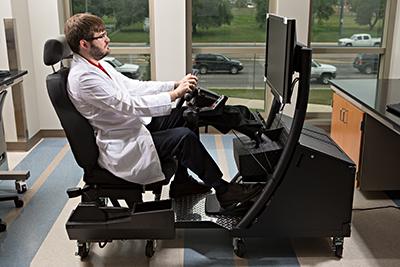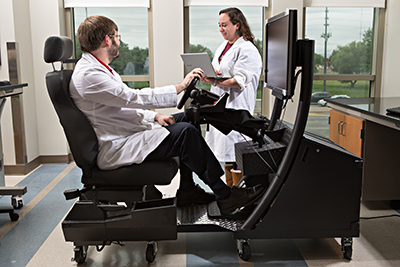Researchers in the Department of Industrial and Systems Engineering at Texas A&M University are making cars smarter and driving safer through cutting-edge technology and research.

Dr. Thomas Ferris, assistant professor in industrial and systems engineering, and his students in the Human Factors & Cognitive Systems Laboratory are collaborating with principal investigator Robert Wunderlich, researchers at the Texas A&M Transportation Institute (TTI), the University of Houston, the University of Michigan and Texas Tech University. This mega-team is investigating possible human- and vehicle-driven causes of unintended vehicle acceleration.
“Motor-vehicle accidents are a complex problem with many potential causal factors, including driver errors,” Ferris said. “Humans are not very good at problem-solving when the vehicle does something they aren’t expecting, especially when under high stress, high workloads or while multi-tasking. So we are trying to use the computational power of the vehicle to detect when drivers exhibit particular stress patterns. If the car knows that the human driver is under the influence of a particular stressor, it can provide support that is more appropriately tailored to the driver’s cognitive state.”

The ‘super-group’, as Ferris has termed the group of transportation research collaborators, has a goal of developing a system that can be installed in an advanced vehicle to detect when a driver’s cognitive state turns problematic.
“This could be a high workload in the driving task or attempting to conduct a secondary task, such as texting and driving,” Ferris said. “Imagine the number of lives that could be saved if the vehicle automation could detect when these distractions pose a problem and then take action to improve safety, such as by guiding the driver’s attention back to the roadway.”
The research is being conducted in a simulation facility at TTI, as well as a test track at Texas A&M’s RELLIS campus. Participants spend time driving in a simulator in the lab, or in a real vehicle on a controlled course, while being monitored using biometric sensors. Researchers monitor heart rate, galvanic skin response, thermal imagery and the amount of sweat a person produces to determine different patterns in changing levels of stress. By using the simulator, researchers are able to explore additional driver conditions, as it allows safely simulated unintended vehicle acceleration or distracted driving.
“What we are actually able to detect is a pattern in sympathetic autonomous nervous system arousal,” Ferris said. “When a surprising, mentally challenging, or strongly emotional experience occurs, the driver is feeling their sympathetic nervous system preparing to fight or flight – to assess a potential threat and to focus cognitive efforts on that threat.”
This is helpful to the person if they are trying to flee an attacking tiger, but can impair the ability to maintain control of a complex system such as a modern vehicle. In addition to distractions, a driver’s cognitive state could also be impacted by stress from an emotional response, being overworked or lack of sleep.
The researchers have explored several concepts to deploy after the system determines that the driver is operating under a problematic state, such as disengaging the transmission or removing distractions like the radio.
“The researchers are testing how indicators of driver stress level can be effectively communicated back to the driver, and whether this can help the driver achieve a calmer state,” explained Ferris.
Although the industry is some distance away from installing this device in all new cars, the group is currently testing a prototype device developed by members of the research team. A number of upcoming studies will test this and other potential solutions in simulation studies on the controlled test-track and maybe even in vehicles on active roadways. The idea is to ultimately test research participants in a realistic setting with real distractions and real emotional responses encountered in traffic.

The super-group published the first article earlier this summer in Scientific Reports, an online open-access research journal from the Nature Publishing Group. The article, ‘Dissecting Driver Behaviors Under Cognitive, Emotional, Sensorimotor, and Mixed Stressors,’ received an altmetric score of 303 only five days after being published online. This score is based on the number of downloads, amount of press coverage and social attention.
The article has since been covered by numerous media outlets including Medical Daily, Reuters, and Gawker.
While the current funded project will be completed at the end of the calendar year, the group has already begun exploring funding to continue this work. Its desire is to have the system installed in all new vehicles to save the lives of many drivers.
This work was funded in part by the Toyota Class Action Settlement Safety Research and Education Program. The conclusions being expressed are the authors’ only, and have not been sponsored, approved, or endorsed by Toyota or Plaintiffs’ Class Counsel.
To learn more about the super group's work, read their article.